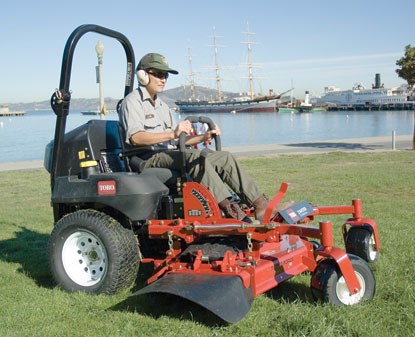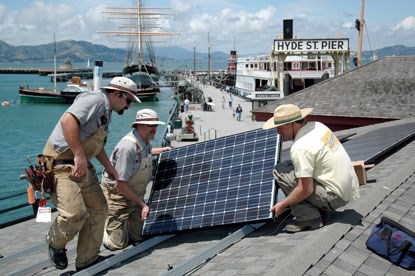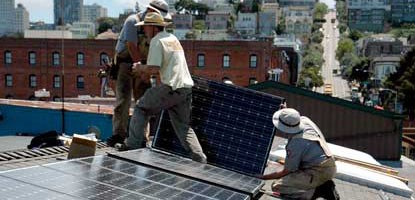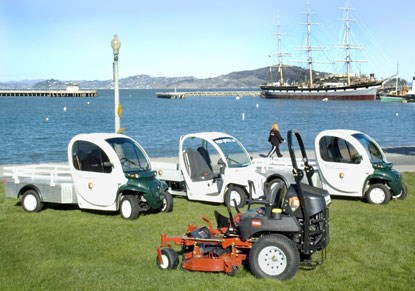
NPS The National Park Service serves as the steward for some of our country’s finest natural and cultural resources. As caretakers, the parks are inspired to reduce, reuse and recycle. On a daily basis, San Francisco Maritime National Historical Park is fostering sustainability and getting greener. The next time you walk out on Hyde Street Pier, look up at the roof of the Small Boat Shop. You will see a small array of solar panels. This photovoltaic system is providing most of the lighting needs for the boat shop, shipwright shop, and ranger office. The system generates about 500 kilowatt hours monthly, reducing the electric bill by $1000 a year. Because these kilowatts are generated by solar power, the park is helping to reduce the release of carbon dioxide, a common greenhouse gas, into the atmosphere.

NPS 
NPS As you step aboard the Eureka ferryboat car deck it may look dark, but your movements will trigger a motion sensor, turning on lights as needed immediately brightening your way. About eight years ago (1998), park maintenance employees began installing motion sensors, twist timers on restroom lights, and replacing incandescent bulbs with energy saving and longer lasting compact fluorescents. By replacing incandescent bulbs with longer lasting, lower watt, compact fluorescents in offices, public spaces, on the pier, and in the ships, the park has garnered significant savings. The compact fluorescent bulbs in the floodlights that illuminate the Hyde Street Pier have lasted for eight years! Energy costs are soaring. By becoming more energy efficient, the park has reduced its electrical energy consumption by 60% over the last five years. On Hyde Street Pier alone this has meant a savings of $22,000 per year. As you sit on a bench in Aquatic Park, admiring the view, the gardener might be mowing the lawn. Take a deep breath and suck in the diesel exhaust–no wait, what’s that smell, vegetable oil? Yes, the new park mower runs on B100, a 100% vegetable-based diesel fuel (photo, top of page). 
NPS You might see maintenance employees hauling garbage and tools in small utility vehicles. Until last year, the park used gasoline-powered vehicles; we have now switched to an all electric-powered fleet. Maintaining historic ships and buildings requires the use of paints, solvents, and cleaning products. A recent painting project used 55 gallons of low VOC (volatile organic compounds) paint. Paints release low levels of toxins into the air. Low VOC paints contains fewer petroleum-based solvents and give off fewer harmful emissions. Over the last year (2006), employees have worked to reduce the amount of hazardous materials stored in the park. Through their efforts, the park inventory of paints, varnishes, thinners, parts cleaners, greases and adhesives has been cut in half. Office recycling bins allow employees to routinely recycle paper, bottles, cans, and batteries and green bins on Hyde Street Pier make it convenient for visitors to recycle bottles and cans. The park uses a techno-trash can to recycle “e (electronic) waste” including floppy discs, CDs, DVDs, cell phones, and cables. An overnight education program for children on Balclutha includes the preparation of three meals. All the food waste is composted through the San Francisco City recycling program. During your visit, we hope you enjoy the park, take away new ideas about maritime history, and continue to practice the three Rs -- Reduce, Reuse and Recycle -- no matter where you are. |
Last updated: December 8, 2014
